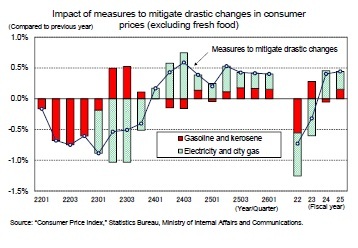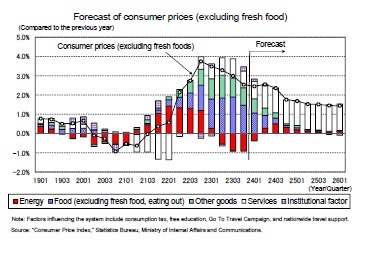- シンクタンクならニッセイ基礎研究所 >
- 経済 >
- 経済予測・経済見通し >
- Japan’s Economic Outlook for Fiscal Years 2023 to 2025 (February 2024)
Japan’s Economic Outlook for Fiscal Years 2023 to 2025 (February 2024)

経済研究部 経済調査部長 斎藤 太郎
このレポートの関連カテゴリ
文字サイズ
- 小
- 中
- 大
2.The real growth rate is projected to be 1.2% in FY2023, 1.0% in FY2024, and 1.1% in FY2025.
The October–December quarter of 2023 marked the second consecutive quarter of negative growth, mainly due to a drop in domestic demand. It is particularly concerning that private consumption and capital investment—the pillars of domestic demand—have declined for three consecutive quarters since the April–June quarter of 2023, despite the normalization of socioeconomic activities following the reclassification of COVID-19 to a Class 5 disease.
Industrial production, which is linked to the business cycle, increased by 1.3% from the previous quarter in the October–December quarter of 2023), the first increase in two quarters. However, a production cutback is inevitable in January 2024 because of the impact of production stoppages following the revelation of fraud at some automakers. The manufacturing production forecast index, which represents the production plans of companies, indicates ˗6.2% from the previous month for January and 2.2% from the previous month for February. Industrial production is expected to turn negative in the January–March quarter of 2024, mainly due to a sharp decline in automobile production.
The impact of production stoppages has already been felt in car sales which fell sharply by 11.5% in January 2024 from the previous month (seasonally adjusted by the Institute). In the January–March quarter of 2024, exports of goods and services are expected to remain sluggish because of the rebound from the increase in service exports in the October–December quarter of 2023. Moreover, domestic private demand, including private consumption and capital investment, is also expected to remain stagnant. Domestic private demand, including private consumption and capital investment, is forecasted to experience an annualized growth rate of 0.1% from the previous quarter (i.e., almost zero growth).
The real GDP will probably increase in the April–June quarter of 2024 to an annualized rate of 1.6% from the previous quarter. However, because the real disposable income of households will not substantially increase until the summer of 2024—when the results of the 2024 spring wage offensive will be reflected and income tax and resident tax cuts will be implemented—a full recovery in consumption is not expected until then. In the first half of 2024, both domestic and foreign demand will continue to face high downside risks.
The tax cuts included in the economic stimulus package are scheduled to be implemented in June 2024 and will boost private consumption in the July–September quarter, which, as a result, is expected to show an annualized growth rate of 2.8% from the previous quarter. Nevertheless, the effects of the tax cuts will only be temporary, and from the October–December quarter onward, an annualized growth rate of around 1% is expected.
 Therefore, the real GDP growth is projected to be 1.2% in FY2023, 1.0% in FY2024, and 1.1% in FY2025.In FY2023, exports will grow slowly but imports will decline against a backdrop of weak domestic demand, thus, external demand will help boost the growth rate. Domestic demand is expected to decline for the first time in three years, mainly due to lower private consumption against a backdrop of lower real incomes accompanying rising prices.
Therefore, the real GDP growth is projected to be 1.2% in FY2023, 1.0% in FY2024, and 1.1% in FY2025.In FY2023, exports will grow slowly but imports will decline against a backdrop of weak domestic demand, thus, external demand will help boost the growth rate. Domestic demand is expected to decline for the first time in three years, mainly due to lower private consumption against a backdrop of lower real incomes accompanying rising prices.In FY2024, domestic demand is expected to turn to growth, as private consumption is predicted to recover because of the increase in real employee compensation and the effects of tax cuts. In addition, capital investment is predicted to remain strong against the backdrop of high corporate earnings.
Although private consumption growth will slow down in FY2025 as a reaction to the tax cuts, capital investment will remain strong, ensuring growth of about 1%, which is slightly above the potential growth rate.
Consumer prices (excluding fresh food, hereafter, core CPI) rose to 4.2% y/y in January 2023, the highest increase in 41 years and 4 months (since September 1981), but then slowed down as a result of the measures taken by the government to ease the burden of electricity and city gas bills, and have remained hovering around the 2% range since September 2023.
 The current price hikes were initially due to large increases in the prices of energy and food, triggered by a sharp rise in import prices because of high crude oil prices and a weak yen. However, energy prices peaked at around 20% y/y in early 2022 and continued to slow down. After entering 2023, energy prices have been negative, partly because of the government’s drastic easing measures. In addition, food prices (excluding fresh food) rose to 9.2% y/y in August 2023 because of the spread of the price pass-on of higher raw material costs associated with soaring import prices, but decreased to 6.2% y/y in December, reflecting the stabilization of food prices in the upstream stage (i.e., import prices and domestic corporate prices).
The current price hikes were initially due to large increases in the prices of energy and food, triggered by a sharp rise in import prices because of high crude oil prices and a weak yen. However, energy prices peaked at around 20% y/y in early 2022 and continued to slow down. After entering 2023, energy prices have been negative, partly because of the government’s drastic easing measures. In addition, food prices (excluding fresh food) rose to 9.2% y/y in August 2023 because of the spread of the price pass-on of higher raw material costs associated with soaring import prices, but decreased to 6.2% y/y in December, reflecting the stabilization of food prices in the upstream stage (i.e., import prices and domestic corporate prices).The price stabilization measures for gasoline and kerosene, in effect since January 2022, will continue until the end of April 2024. In addition, the measures for electricity and city gas, in effect since February 2023, will continue until April 2024, with an expected reduction of subsidies in May.
The current over-the-counter price of gasoline is about 190 yen per liter, without subsidies, and unless the yen appreciates and crude oil prices fall significantly, the price will remain well above the government’s target of 175 yen per liter for May 2024. Hence, it is highly probable that the drastic easing measures for gasoline and kerosene will continue after May 2024.
The current forecast assumes that the gasoline subsidy will remain as it is until the end of FY2024 and will continue in FY2025 with a reduced amount and that the subsidies for electricity and city gas will continue throughout FY2024 with a reduced amount and will end in FY2025.
The drastic easing measures depressed the core CPI inflation rate until the October–December quarter of 2023 but will boost it starting in the January–March quarter of 2024. On a fiscal year basis, the impact of the drastic easing measures on the core CPI inflation rate is expected to be about ˗0.7% in FY2022, ˗0.3% in FY2023, 0.4% in FY2024, and 0.4% in FY2025.
The rise in import prices, which are the main cause of high prices, has stopped and the increase rate in the prices of goods has already peaked. By contrast, the prices of services, which are linked to labor costs, have grown at about 2% y/y since August 2023, whereas, in December, the prices of goods (excluding fresh food) and services grew at the same rate (2.3%).
Furthermore, the prices of services which continue to grow in the low 2% range, slightly above the base salary increase in 2023, and will remain high as companies continue to pass on increased labor costs to their consumers.
Although the increase rate of the core CPI continues to be influenced by various support measures taken by the government, the underlying trend continues to slow down. Notwithstanding, the core CPI growth rate is not expected to fall below the BOJ’s target of 2% until the second half of FY2024, when the positive effect of the weaker yen is expected to wane, and the increase rate of the prices of food and other goods is expected to slow down.
 The increases in the prices of goods and services in FY2022 were mostly due to rises in the prices of energy and food (excluding fresh food and eating out). Nonetheless, the focus of price increases is shifting from goods to services, and from FY2024 onward, services will exceed goods in their contribution to CPI growth.
The increases in the prices of goods and services in FY2022 were mostly due to rises in the prices of energy and food (excluding fresh food and eating out). Nonetheless, the focus of price increases is shifting from goods to services, and from FY2024 onward, services will exceed goods in their contribution to CPI growth.The core CPI is projected to be 2.8% in FY2023, 2.1% in FY2024, and 1.5% in FY2025, following the 3.0% seen in FY2022. In addition, the core CPI is projected to be 3.8% y/y in FY2023, 1.9% in FY2024, and 1.5% in FY2025 following the 2.2% seen in FY2022.
Please note: The data contained in this report has been obtained and processed from various sources, and its accuracy or safety cannot be guaranteed. The purpose of this publication is to provide information, and the opinions and forecasts contained herein do not solicit the conclusion or termination of any contract.
(2024年02月21日「Weekly エコノミスト・レター」)
このレポートの関連カテゴリ

03-3512-1836
- ・ 1992年:日本生命保険相互会社
・ 1996年:ニッセイ基礎研究所へ
・ 2019年8月より現職
・ 2010年 拓殖大学非常勤講師(日本経済論)
・ 2012年~ 神奈川大学非常勤講師(日本経済論)
・ 2018年~ 統計委員会専門委員
斎藤 太郎のレポート
| 日付 | タイトル | 執筆者 | 媒体 |
|---|---|---|---|
| 2025/09/17 | 貿易統計25年8月-関税引き上げの影響が顕在化し、米国向け自動車輸出が数量ベースで大きく落ち込む | 斎藤 太郎 | 経済・金融フラッシュ |
| 2025/09/08 | 2025・2026年度経済見通し-25年4-6月期GDP2次速報後改定 | 斎藤 太郎 | Weekly エコノミスト・レター |
| 2025/09/01 | 法人企業統計25年4-6月期-トランプ関税の影響で製造業は減益も、非製造業が堅調を維持 | 斎藤 太郎 | 経済・金融フラッシュ |
| 2025/08/29 | 鉱工業生産25年7月-自動車中心に下振れリスクが高く、7-9月期は減産の可能性 | 斎藤 太郎 | 経済・金融フラッシュ |
新着記事
-
2025年09月17日
ふるさと納税「お得競争」の終焉-ポイント還元の廃止で問われる「地域貢献」と「持続可能な制度」のこれから -
2025年09月17日
貿易統計25年8月-関税引き上げの影響が顕在化し、米国向け自動車輸出が数量ベースで大きく落ち込む -
2025年09月17日
「最低賃金上昇×中小企業=成長の好循環」となるか?-中小企業に託す賃上げと成長の好循環の行方 -
2025年09月17日
家計消費の動向(二人以上世帯:~2025年7月)-実質賃金改善下でも「メリハリ消費」継続、娯楽支出は堅調を維持 -
2025年09月16日
インド消費者物価(25年9月)~8月のCPI上昇率は+2.1%に上昇、GST合理化でインフレ見通しは緩和
レポート紹介
-
研究領域
-
経済
-
金融・為替
-
資産運用・資産形成
-
年金
-
社会保障制度
-
保険
-
不動産
-
経営・ビジネス
-
暮らし
-
ジェロントロジー(高齢社会総合研究)
-
医療・介護・健康・ヘルスケア
-
政策提言
-
-
注目テーマ・キーワード
-
統計・指標・重要イベント
-
媒体
- アクセスランキング
お知らせ
-
2025年07月01日
News Release
-
2025年06月06日
News Release
-
2025年04月02日
News Release
【Japan’s Economic Outlook for Fiscal Years 2023 to 2025 (February 2024)】【シンクタンク】ニッセイ基礎研究所は、保険・年金・社会保障、経済・金融・不動産、暮らし・高齢社会、経営・ビジネスなどの各専門領域の研究員を抱え、様々な情報提供を行っています。
Japan’s Economic Outlook for Fiscal Years 2023 to 2025 (February 2024)のレポート Topへ





















 各種レポート配信をメールでお知らせ。読み逃しを防ぎます!
各種レポート配信をメールでお知らせ。読み逃しを防ぎます!




